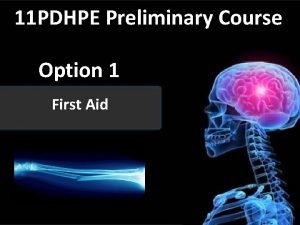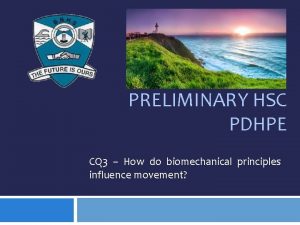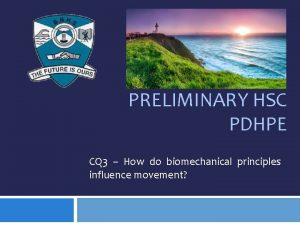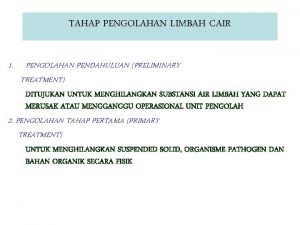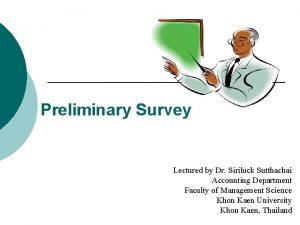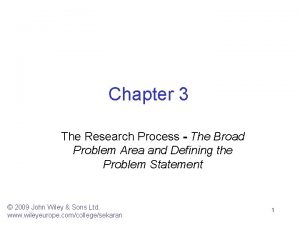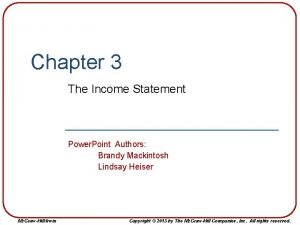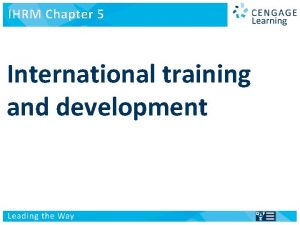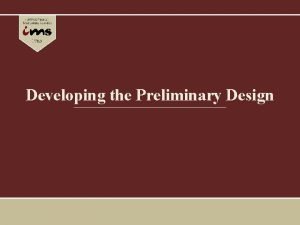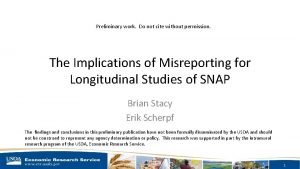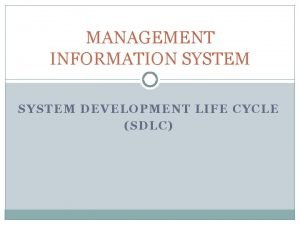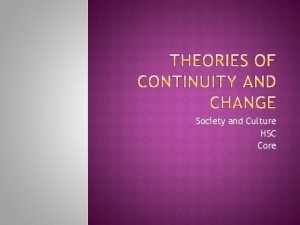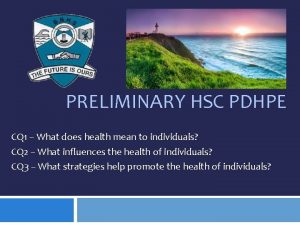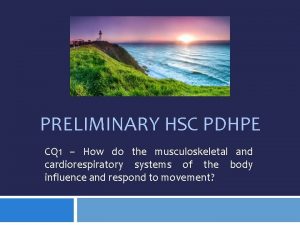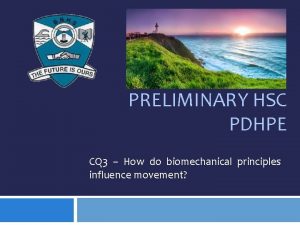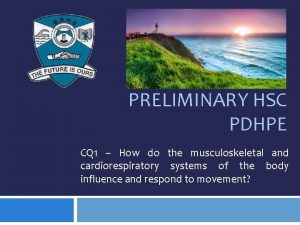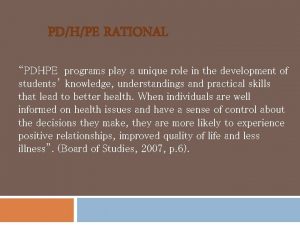PRELIMINARY HSC PDHPE CQ 1 What does health










































































- Slides: 74

PRELIMINARY HSC PDHPE CQ 1 – What does health mean to individuals?

What does health mean to individuals? Students learn about: meanings of health definitions of health dimensions of health relative and dynamic nature of health perceptions of health perceptions of their health perceptions of the health of others eg parents, the elderly, the homeless implications of different perceptions of health as social constructs impact of the media, peers and family health behaviours of young people the positive health status of young people protective behaviours and risk behaviours Students learn to: examine the dynamic nature of health by exploring: the interactions between the dimensions the concept of good health the health continuum how health changes over time how an individual’s circumstances affect their health examine perceptions of health by exploring questions such as: how healthy am I? How healthy do other people think I am? how healthy do I think other people are? why would my perceptions of health be similar or different to others? how might an individual’s perception of health affect their behaviour and wellbeing? determine the degree to which perceptions of health are socially constructed explore current research and information to: identify the prevalence of and trends in the health behaviours of young people challenge the accuracy of societal perceptions of the health behaviours of young people identify protective and risk behaviours for health issues relevant to young people and predict how risk decreases or increases when multiple factors interact

What does health mean to individuals? Define what health means to you.

1. Meanings of health Definitions of health In approximately 500 BC, the Ancient Greek medical writer Alcmaeon defined health as ‘the equal and cooperative mingling of the separate elements of human nature’. In the 1913 edition of Webster’s Dictionary, health is defined as ‘the state of being hale, sound, or whole, in body, mind, or soul; especially, the state of being free from physical disease or pain’. In 1947 the World Health Organization (WHO) defined health as ‘a state of complete, physical, mental, and social well-being and not merely the absence of disease or infirmity’.

In 1957 the WHO definition was changed to read: ‘Health is a condition or quality of the human organism which expresses adequate functions under given genetic and environmental conditions’. In 1986, the Australian Better Health Commission in Looking Forward to Better Health made a statement about health: ‘To the community, good health means a higher standard of living, greater participation in making and implementing community health policies and reducing health costs’.

Dimensions of health Physical health is not the only aspect of being healthy. It is now widely recognised that there is a relationship between a person’s body, mind and spirit. This is a holistic view of health. The modern concept of health comprises various dimensions: physical, mental or emotional, social and spiritual.

Physical health is best described as the efficient functioning of the body. It is the body’s capacity to participate in everyday activities and the absence of signs of disease, such as asthma, epilepsy or diabetes. This dimension includes characteristics such as body size and shape, level of fitness, energy level, weight and ability to recover from illness.

Mental health is an umbrella term that encompasses the dimensions of emotional, social and spiritual health. Mental health refers to the ability to adapt to change and cope with adversity. It involves thinking and communication skills, the ability to learn and relate to others, resilience and self-esteem.

Emotional health refers to the ability to express emotions when they are appropriate, control them when they are not and avoid expressing them inappropriately. Emotional health includes the ability to develop good self-esteem and a positive self image. It can also refer to the ability to resolve conflict and maintain a realistic perspective of situations so as to decrease our stress levels. These skills assist us to develop a positive sense of self and achieve a balanced state of emotional health.

Social health refers to the ability to form and maintain satisfying interpersonal relationships. It includes the ability to relate to parents, teachers and friends in a way that is accepted by our community. It also involves being able to follow accepted standards of behaviour (such as waiting in a queue or taking our turn in a game) and interacting positively in group situations.

Spiritual health The term ‘spiritual health’ has different meanings for different individuals. This dimension may involve a belief in a supreme being or a way of life that is prescribed by a particular religion. For others, spiritual health may mean being part of a ‘greater scheme’. Believing in a spiritual world or greater scheme often assists people to make decisions in their lives. Spiritual health can also mean being in tune with oneself. It also includes the feeling of unity with the environment—a sense of oneness with others and with nature—and a guiding sense of the meaning or value of life. It may also refer to the ability to understand express one’s purpose in life; to accept one’s experience of love, joy, pain, sorrow and contentment; to maintain a sense of wonder at life’s experiences; and to respect all living things.


Relative and dynamic nature of health The WHO defines health as ‘a state of complete physical, mental, and social well-being and not merely the absence of disease or infirmity’. This statement implies that a person cannot be considered healthy unless he or she has a complete state of well-being.

Relative nature of health Relative means in relation to another period of time, in relation to your potential or in relation to others. Relative to your peers, are you healthy? Relative to your level of health five years ago, are you healthy? Dynamic nature of health Our state of health changes over time, so we can say it is dynamic. Health is constantly changing.

The interactions between the dimensions Health can be seen as an interaction between the dimensions of health. If the status of one dimension is compromised, the other dimensions will be affected. Create 2 examples that demonstrate the dynamic and relative nature of health. Refer to the dimensions of health.

Examples For instance, when we have a severe cold, we are less likely to want to interact socially with others and may feel depressed. Our impaired physical wellbeing affects the other dimensions of our health. 1. When we feel stressed due to work or school (eg assessment tasks, exams) we build up added stress in our body and our immune system starts to shut down 2. After a long period of non exercise, we start to feel tired and tend to get down on ourselves. Also, our hormones start to act up causing pimples etc.

Define the following terms: Morbidity a measure of the number of illness/disease (in general, or due to a specific cause) in a population, scaled to the size of that population, per unit time. Mortality a measure of the number of deaths (in general, or due to a specific cause) in a population, scaled to the size of that population, per unit time. Prevalence the total number of cases of the risk factor in the population at a given time, or the total number of cases in the population, divided by the number of individuals in the population Incidence a measure of the risk of developing some new condition within a specified period of time. Although sometimes loosely expressed simply as the number of new cases during some time period Heredity (factors) is the passing of traits to offspring (from its parent or ancestors). These may include: risk of cancer, height, weight, skin and eye colour etc Socio-economically disadvantaged are those who are on low incomes who struggle to supply themselves and their family with food, clothing and shelter.

The concept of good health It is important to understand the meanings that people associate with the concept of good health. For a child, being healthy might mean eating plenty of vegetables and participating in a variety of physical activities. For a young person, being healthy may mean training three nights a week at soccer, never getting a cold during winter and having plenty of friends. For an older person, being healthy may mean having the physical ability and motivation to complete everyday tasks and to entertain relatives who visit each week.

The concept of good health In the past, health was equated with an absence of illness —if you were not sick, you were healthy. Communicable diseases caused many cases of illness and death. Being healthy meant not suffering from disease. The nature of health was generally linked to a person’s physical state of well-being. In other words, health was discussed in terms of the efficient functioning of the body. The body was considered to be a ‘biological machine’ and illness was viewed as a malfunction. Interventions or medical responses to address these malfunctions involved surgical or chemical treatment. Few people thought about how factors outside the body, such as the environment, contributed to the development of an illness.

Later, health became linked with the conditions of the physical environment. Water supplies, waste disposal and sanitation were identified as potential sources of poor physical health, and measures were taken to improve standards of hygiene. Advances in medical technology and research resulted in the discovery of medications, anaesthesia and immunisation. The ‘biological machine’ approach to health changed to the ‘biomedical’ approach to health. The health care-giver now aimed to improve quality of life, help people avoid disease and alleviate disease if it did occur. It became possible to treat and even prevent communicable illnesses.

More recently, there has been another shift in the way we think about health. Communicable diseases are no longer highly prevalent in our communities. Lifestyle related diseases, such as heart disease and cancer, are the primary causes of morbidity (level of illness) and mortality (death rate). When discussing health today, we consider the social, economic and political environments in which we live and how these environments impact on our health status.

The health continuum Health status can be conceptually positioned on a health continuum. The health continuum ‘measures’ our health status at any moment in time. We move along this continuum continually each minute, hour, day or year. One minute you may be walking on the beach with your partner feeling relaxed, happy and physically well. The next minute he or she may tell you that your relationship is over. Instantly, your health status moves along the continuum as your state of emotional health is affected.


How health changes over time? Our state of health has the potential to change regularly, even from minute to minute. Imagine you are attending a school sports event. You feel happy, you have lots of friends and you almost never suffer from a physical illness. In the next instance, you trip while running, which causes you to sprain your ankle. You will be unable to participate for the next few weeks. This means you will miss making the finals, which you have been looking forward to all season. Your state of health has changed drastically in a short instant in time.

Our state of health also changes as we age. Our level of fitness may improve, our circle of friends may change and our memory may fade. Dimensions of our health will change status, or level, over the years. Over time our health can improve or deteriorate depending on our circumstances.

How an individual’s circumstance impacts on health? Our health status changes in relation to our circumstances. Many factors can have a direct impact on our health and well-being. Our health potential is determined by our heredity, experiences, ability to make informed health decisions and opportunities to access health services. Our heredity will determine some predisposing health risk factors, such as body type. Whether we are healthy will largely be determined by the interaction of heredity and environmental factors. If we undertake health-enhancing behaviours we can maintain an adequate level of health. Such behaviours include socialising and participating in physical activity regularly, eating sensibly, and relaxing when stressed.

Playing cricket as a child probably meant hitting a six over the fence, laughing with friends and taking a wicket when bowling. Playing cricket as an adult in a national match would hold different meanings for us, such as feelings of national pride as a result of representing our country, and feelings of pressure to perform well and take responsibility as a team member. If we enjoyed our experiences of cricket when we were young, we are more likely to develop a positive attitude towards cricket in later life. If, however, we were usually picked as ‘twelfth man’ and rarely had the opportunity to enjoy playing the game, we are more likely to discontinue cricket—and all other physical activity—in our teens and twenties.

Young people living as refugees or in socioeconomically disadvantaged communities encounter additional stresses. Their transition to adulthood is often made more difficult by the absence of their usual role models and sociocultural system. They may have experienced personal trauma, including armed conflict, sexual abuse and other forms of violence, or harm to or loss of family members and friends; disruption of schooling or employment; and loss of community support.

Discuss the interactions between the dimensions of health All aspects of health intertwine with each other at various points of a person’s life. Sometimes they complement each other, and other times they contrast. For example, when someone is feeling down (‘depressed’), they may tend to have low levels of energy and their immune system may suffer. When people are active and physically healthy, their sense of belonging may be higher and they feel emotionally stable.

Describe the term ‘concept of good health’ Health is a concept which does not merely relate to the absence of disease, of healthy working of organs, or having good thoughts. Health is a holistic concept. It relates to a person as a whole. Not just the person you see, but also the person you ‘feel’.

State what the ‘health continuum’ is The health continuum is an indicator of how an individual’s health is at any given point in time. It constantly changes.

Discuss how health changes over time You may feel happy, have lots of friends and you almost never suffer from a physical illness. In the next instance, you trip while running, which causes you to sprain your ankle. You will be unable to participate for the next few weeks. This means you will miss making the finals, which you have been looking forward to all season. Your state of health has changed drastically in a short instant in time.

Explain how an individual’s circumstances affect their health Whether we are healthy will largely be determined by the interaction of heredity and environmental factors. If we undertake health-enhancing behaviours we can maintain an adequate level of health. Such behaviours include socialising and participating in physical activity regularly, eating sensibly, and relaxing when stressed. Our experiences can have a great impact on the way we view health. People living as refugees or in socio-economically disadvantaged communities encounter additional stresses. Their transition to adulthood is often made more difficult by the absence of their usual role models and socio-cultural system. They may have experienced personal trauma, including armed conflict, sexual abuse and other forms of violence, or harm to or loss of family members and friends; disruption of schooling or employment; and loss of community support.

2. Perceptions of health individual perceptions of their health A person’s perception of his or health status is a subjective rating. Some people perceive themselves as healthy despite suffering from one or more chronic diseases, while others perceive themselves as ill even when no objective evidence of disease can be found. Health and well-being play an important role in defining many aspects of a young person’s life. The Youth. Speak report, published in 2008 reveals young people’s perceptions of health. The report records the findings of the Australian Government’s Youth. Speak consultation project, which was carried out to determine the views of 12 000 young Australians aged between 12 and 24 years (extract provided separately). http: //www. missionaustralia. com. au/publications/research/youngpeople#gi. Skfzd. OKlql 6 Oh. Q. 97

perceptions of the health of others eg parents, the elderly, the homeless Australians are generally healthy and their health continues to improve. Unfortunately, this is not true for all Australians. There are many factors that can contribute to health inequalities. These include age, gender, ethnicity, social and economic status, disability and the geographic area where a person resides. Some of these factors cannot be changed (such as age), but many inequalities result from socio-economic differences. Examples are a person’s material resources, living conditions in childhood, and exposure to racism and discrimination. Further examples are a person’s access to educational opportunities, safe working conditions and effective health services. Most of these factors can be improved.

It is important to study the perception of health of population groups to understand why those groups may have particular health problems. This helps us understand why certain groups need extra consideration when determining health policies and in what ways improvements in their health can be achieved. Socioeconomically disadvantaged people, Indigenous Australians, prisoners and those living in rural and remote areas experience various levels and types of health disadvantage. Other groups, including those born overseas and members of the defence forces, may not have poorer health but do have certain concerns that influence their health status.

People who are homeless experience negative social and health consequences. Gastroenteritis, bronchitis and asthma have been associated with homelessness. Mental illnesses, such as depression and schizophrenia, are also relatively common among homeless people. The health of others can also be perceived through the concept of life stages. Life stages are age groupings: babies (and their mothers), children, adolescents, adults and those aged 65 years and over. A life-stage perspective helps us identify the health needs of certain age groups and take action to address any areas of concern. For example, there are specialist health professionals and services devoted to expectant mothers, infants and other children, young people and the elderly. Australians today are living longer. Older Australians (those aged 65 years and over) enjoy better health than their counterparts in previous generations.

Parents play an important part in the lives of most young people. Young people rely on their parents or carers to provide them with physical, emotional and economic support. Parents and carers influence the health and health-related behaviour of young people in their care. In general, Australian parents have good health. Those parents with a disability or chronic health condition may be unable to provide their children with sufficient physical, emotional or economic support. In such circumstances, the child may be required to take on greater responsibilities or, in some cases, care for the parent. While taking on a caring role may have positive effects on a young person’s development, such as engendering increased maturity or compassion, it is also likely to be both physically and emotionally challenging. � Provide an example of this…

implications of different perceptions of health Different perceptions of health will have major implications for public health. Public health is the planned response to protect and promote health, and to prevent illness, injury and disability. It is the basis for identifying public health issues, problems and priorities, and for designing and implementing interventions. Essentially, public health interventions focus on prevention, promotion and protection rather than on treatment.

At the individual level, a person’s perceptions of health determine whether or not he or she takes appropriate actions. At the societal level, different perceptions drive the agenda of agencies responsible for developing health strategies and interventions. They may lead to policies that affect the safety, cost and even existence of many health products and technologies. Awareness of different health perceptions guides public health activities to take the most appropriate path for intervention in the form of programs, campaigns or events. These may involve methods such as health education, lifestyle advice, infection control, risk-factor monitoring, and tax loadings to discourage unhealthy lifestyle choices. They also apply in multiple settings (such as in schools, homes and workplaces and via general practitioner consultations and the media) and relate to a broad spectrum of health issues.

Different perceptions of health have an impact on the country’s perception of health. For example, they influence the extent and quality of its health services. They also affect a range of other health determinants, including socio-economic and environmental conditions and the health behaviours of individuals.

perceptions of health as social constructs Health can be viewed from a socio-cultural perspective; that is, from the viewpoint of society as a whole. This allows us to look at the underlying causes or contributing factors relating to health status. Health status is not only an individual concern; often it has a wider community impact. The choices we make about health are based on the social, cultural and economic conditions of our family and community life. Until recently, health was viewed using a biomedical approach where the body is seen as a biological machine consisting of individual parts. When a particular part of the body is damaged or ill, it is identified and treated. The difficulty with this approach is that it cannot respond to the interrelated sociocultural influences that contribute to a disease or illness.

How do social attitudes affect health status? The social environment includes social, cultural, physical, political and economic factors that can affect health status. Sexual orientation, for example, can impact on health status. Young homosexual men are more likely than heterosexual men to encounter disapproval because of their sexuality. They are also at greater risk of developing a stress-related illness, such as depression, and of engaging in self-destructive behaviours. Lesbian women have a higher incidence of alcohol and drug use than their heterosexual peers.

Socio-economic status can also impact on health status. People with a low socio-economic status are more likely than people from higher socioeconomic groups to smoke, drink alcohol, participate in drugtaking and have an inadequate diet. Young females from lower socio-economic backgrounds are more likely than other females to discontinue their education and to have short-sighted career ambitions. People who feel severely limited in their choice of career and lifestyle are more likely than other people to drink too much alcohol and eat poor quality, high-calorie food.

Responsibility for health status In the past, our attitude towards health status placed the blame for ill-health on the individual. It saw ill health as resulting from engaging in an unhealthy lifestyle, failing to avoid dangerous or illness producing situations, or neglecting to consult the correct health professional.

Viewing health as a social construct challenges the notion that health is solely the responsibility of the individual. Consider the case of a teenage girl in a rural area who is experiencing an unwanted pregnancy. To blame her for not accessing health services to seek contraception is to blame the victim. The girl may not have the personal skills or confidence to request a contraceptive device from her family doctor or pharmacist. She may not be able to afford the regular purchase of the contraceptive or she may not have access to transport to a pharmacy. Also, maintaining privacy in these situations can pose difficulties. The town where she lives may have only one general practitioner and the girl may be concerned that the general practitioner will tell her parents about her pregnancy. The girl may not have her own Medicare card and so may need to use her family’s Medicare card.

Changes in the meaning of health over time Understanding that health is socially constructed also allows us to, over time, change how we define health. For example, in the nineteenth century, people believed that the acceptable and fashionable body shape for women was well rounded. After World War II, large breasts and broad hips were viewed as an indication of good health and fertility. In recent decades, however, the fashion industry has promoted an image of waif-like figures for women. This change of fashion has important implications for the health status of women. Women who want to look waif thin are likely to take part in health-compromising behaviours, such as excessive dieting and compulsive exercising.

For example, throughout the twentieth century, Australians believed that lying in the sun to acquire a deep tan was a healthy activity. Until recently, this belief was supported by the media, which presented deep tans as fashionable. During the last 30 years, research results have shown that excessive exposure to the sun’s rays is an important contributing cause of skin cancer. The Cancer Council altered our meaning of health by publicising campaigns such as ‘Slip, Slop, Slap, Wrap’ to encourage all of us to wear hats, T-shirts, sunscreen and sunglasses and limit our exposure to the sun’s rays during summer. More recently, there has been a Sun. Smart campaign focused on reminding teenagers in particular of the dangers of tanning, whether from the sun’s rays or by using a solarium. The campaign featured Clare Oliver, who died of a melanoma.

The public health approach Viewing health and physical activity as a social construct allows us to identify the pattern of social factors in the health of the community as a whole. We can discover why these factors develop and respond to them by adopting appropriate community strategies. Developing social solutions to these health problems is termed the public health approach. This approach involves ensuring greater access to health services for disadvantaged social groups. Access includes developing health literacy skills— the ability to understand health information and apply this knowledge by selecting appropriate health services. When we adopt the public health approach, we are applying social justice principles. This means we are supporting the individual and group needs of community members. Particular social groups may need to be targeted using this approach. For example, body image is being recognised as an important public health issue. It has usually been associated with young women. However, there is increasing evidence to indicate that issues surrounding body image also affect young men. The following article addresses the impact of individual, family, cultural and social factors on a person’s weight, eating patterns and attitudes towards physical activity and the prevalence of disordered eating.

impact of the media, peers and family The media and a person’s peers and family can impact on that person’s health in a positive and/or negative way. Children and young people can learn healthy or unhealthy habits by observing the behaviour of their parents/carers. Such behaviours include smoking, alcohol intake, level of physical activity and eating patterns.

A major source of teenagers’ security is found in the approval of their peers. Peer acceptance and influence is a very strong motivating force. Friends and school acquaintances can be influential in the area of health through exchanging healthrelated information, modelling behaviours, exerting peer pressure and teasing. An example of how peers can influence each other is the adoption of health risk behaviour, such as binge drinking, or taking up a positive health behaviour, such as participating in regular physical activity. The mass media (including television, movies and print advertising) has a significant influence on young people’s attitudes and intentions in relation to health. For example, there is evidence that tobacco advertising may influence teenagers’ behaviour in relation to smoking by portraying smoking as attractive and claiming that it has a weight-reducing effect.

3. Health behaviours of young people Adolescence is a time of rapid emotional, physical and intellectual transition, when young people move from being dependent children to independent adults. This is also a time when young people face a range of life events and make decisions that can have an impact on their immediate and longer-term health and well-being. Some of these decisions relate to schooling and career paths, relationships, sexual behaviours, employment, finances, use of drugs and alcohol and contact with the justice system. For Australian youth, the transition to adulthood is made more complex by the social, economic, environmental and technological changes in Australian society over recent decades.

Compared with previous generations, young people today have fewer siblings and are more commonly living in single-parent or blended families, or in families with both parents in the workforce. The pathways from education to work are now more varied and complex and often extend over longer periods; together with decreased job security this means that young people often live in the parental home for longer.

the positive health status of young people

Summarise the key trends identified in the report under the headings provided below.

protective behaviours and risk behaviours Changes in the lives of children and young people in Australia Many of the changes that have taken place in Australia over the last 10– 20 years have significantly altered the environment in which Australian children and young people are growing up. These include social changes, such as: � changes in the prevalence of different family types, such as blended and lone-parent families � a trend towards having fewer children and having children later in life � a greater proportion of mothers in the workforce and an increased use of child care. � In addition, technological advances have changed the way children and young people learn and interact with their friends and community. �

More young people are participating in further study after high school and are entering the workforce later in life. This has led to more young people living at home with their parents well into their twenties. The health of children today has seen some improvements. Compared with past generations, fewer children die before the age of 20; more grow up free from infectious diseases, such as measles and polio; and more survive serious illnesses, such as cancer, or live longer with genetic conditions, such as cystic fibrosis. However, obesity, chronic disease, and mental and behavioural problems and related disabilities have become concerns. Key factors that contribute to the well-being of young adults include receiving secondary and post-school education; making a good transition from school to work; participating economically and socially; having no or limited exposure to, or participation in, criminal activities; and being prepared for parenthood.

By 2020, children and youth will represent only 20 % of the population. In 2006, children aged under 5 years made up 6 % of the population, children aged 5 – 12 years comprised 11 %, and teenagers 10 %. In total, Australians aged under 20 years made up 27 % of the population. The size and composition of the child and youth population are changing and some population groups have experienced greater growth. This has been most noted in the proportion of Australians aged under 20 years who were Indigenous: it has increased from 8. 2 % to 8. 8 %.

Mortality rates and causes of mortality provide important information for public health policy and planning and give significant indications of a population’s health. They provide information about the circumstances around the time of death, as well as the changes in social and environmental conditions, medical intervention, lifestyles and trends in underlying risk factors. As children move through adolescence and become more independent, the above factors become more significant as they develop new skills, such as driving and job skills, and have greater exposure to alcohol and other drugs. Common hazards for young people include traffic accident injuries, psychological problems and the harmful effects of the use of alcohol and other drugs.

Injury and poisoning Among young people, injury (including poisoning) is the leading cause of death. It is the second highest contributor to the burden of disease after mental disorders and the third leading cause of hospitalisation. Injury can end in significant disability. The main causes of injuries include falls from heights or during sport, transport accidents, assault and intentional self-harm. When young people experiment with alcohol and other drugs they are more prone to certain types of injuries, such as falls, transport accidents, accidental poisoning and assault.

Mental health disorders, particularly anxiety and depression, are the main cause of disability among young Australians aged 15– 24 years. Many young people with mental health problems are undiagnosed or do not seek help. There are many complex reasons why an individual may develop a mental disorder. They may include individual characteristics; family, social, community and cultural factors; and life changing events and situations. Young people with a mental health disorder are more likely to have poor physical health, lower academic attainment and experience joblessness.




Overweight and obesity Young people who are overweight or obese are more likely to be obese as adults. They are also at increased risk of psychological problems and developing cardiovascular conditions, asthma and type-2 diabetes. Long-term problems include increased risk of coronary heart disease, diabetes, some cancers, gall bladder disease, osteoarthritis and endocrine disorders. Therefore, reducing youth overweight and obesity is important in the prevention of chronic disease. Social isolation and lower educational and income attainment may also be experienced by those who are overweight or obese. Risk factors linked with obesity may include type and amount of physical activity, dietary intake and eating patterns, television viewing, inherited characteristics, ethnicity, artificial feeding as infants and the presence of other health conditions.


Substance use The most commonly used substances by young people are alcohol and tobacco and, on a lesser scale, marijuana and other drugs. Health and social problems associated with substance use in the short term may include hospitalisations due to irresponsible consumption and related injuries, psychotic disorders, dependence, withdrawal symptoms and amnesia. Long-term use of alcohol and other drugs can lead to depression, liver damage, infections with blood borne diseases, heart and brain damage, and risk of cancers and other serious health conditions. Drug abuse has also been linked with social problems, such as legal and financial difficulties and conflict within the family and relationships. Other consequences of drug abuse include antisocial behaviour, poor parental control and supervision, poor family bonding, low self-esteem, academic failure, leaving school early and poor connection with family, school and community. Parents who use drugs during pregnancy place their child at risk of experiencing early behavioural and emotional problems.


Education and employment Young people with higher levels of education tend to experience fewer illnesses and have better mental health than those with lower levels of education. Through education, young people gain knowledge and understanding about health, such as health risk and protective factors. It also offers access to employment that is safe, secure and generally better paid and more rewarding. Other positive benefits include lower stress levels and reduced risk of injury. Compared with those who completed Year 12, young people who did not finish high school have fewer options in regard to post school education, training and employment. They are also more likely to experience joblessness. Young people who have jobs gain financial independence and tend to have self-control, self confidence and wider social contacts. Those who are unemployed, have insecure employment or work in negative conditions are at risk of having low self esteem, and poor physical and mental health.



Crime Adolescence is the life stage when people are most at risk of being victims of crime and becoming involved in criminal activities. They are also more vulnerable to being victimised, which may lead to them later victimising others. Young people in these circumstances may not finish school, which impacts on their socioeconomic situation in early adulthood. It may also lead to depression and suicidal ideation and behaviour. Young people in the criminal justice system are most disadvantaged because they experience high levels of socio-economic stress, major physical and mental health needs, and a history of physical abuse and childhood neglect.


Revision/Homework task Read the article ‘I’m gonna sound like a drunk here’: constructions of volume of consumption’ and then answer the questions below Explain the effects of binge drinking on young people and how it can have an impact on their current and future health. The government has invited the community to propose strategies to reduce binge drinking and improve the health of young people. Refer to the conclusion in the article above. Discuss what strategies would reduce binge drinking and improve the health of young people. Identify the prevalence of and trends in the health behaviours of young people Relate the accuracy of societal perceptions of the health behaviours of young people
 What is situational analysis first aid
What is situational analysis first aid Hsc pdhpe
Hsc pdhpe Mortality definition pdhpe
Mortality definition pdhpe Ottawa charter pdhpe
Ottawa charter pdhpe Centre of gravity pdhpe
Centre of gravity pdhpe Fluid mechanics pdhpe
Fluid mechanics pdhpe Fitt principle for volleyball
Fitt principle for volleyball Validity pdhpe
Validity pdhpe Totaps method
Totaps method Continuous training pdhpe
Continuous training pdhpe Oxygen uptake pdhpe
Oxygen uptake pdhpe Pdhpe core 1 practice questions
Pdhpe core 1 practice questions Convection pdhpe
Convection pdhpe Graduated exercise pdhpe
Graduated exercise pdhpe Neural recovery
Neural recovery Preliminary budget
Preliminary budget Preliminary treatment adalah
Preliminary treatment adalah Preliminary survey audit
Preliminary survey audit P 波
P 波 Preliminary design review example
Preliminary design review example Preliminary material
Preliminary material Mla rough draft example
Mla rough draft example Preliminary interview
Preliminary interview Broad problem area examples
Broad problem area examples Holt company's variable expenses are 70 of sales
Holt company's variable expenses are 70 of sales Fly leaf 2
Fly leaf 2 Preliminary graphics examples
Preliminary graphics examples Goto/sdle
Goto/sdle How to write a preliminary thesis statement
How to write a preliminary thesis statement Preliminary rifle instruction
Preliminary rifle instruction Arrt preliminary score
Arrt preliminary score Image of development
Image of development A preliminary synopsis of a film's action is called a
A preliminary synopsis of a film's action is called a Determine junktrader’s preliminary net income.
Determine junktrader’s preliminary net income. Milady chapter 20 review questions
Milady chapter 20 review questions Preliminary business plan
Preliminary business plan Preliminary prototype
Preliminary prototype Preliminary audit strategy
Preliminary audit strategy Preliminary outline
Preliminary outline Which type of melanin lends black and brown colors to hair?
Which type of melanin lends black and brown colors to hair? Shower approach in international marketing
Shower approach in international marketing Ihrm training and development
Ihrm training and development Preliminary objectives
Preliminary objectives Preliminary discussion meaning
Preliminary discussion meaning Preliminary statement definition
Preliminary statement definition Preliminary review definition
Preliminary review definition Materiality is a relative rather than an absolute concept
Materiality is a relative rather than an absolute concept Ifsqn
Ifsqn Preliminary marketing plan
Preliminary marketing plan Pdr preliminary design review
Pdr preliminary design review Thesis statement fill in the blank
Thesis statement fill in the blank Preliminary ruling
Preliminary ruling Preliminary design review template
Preliminary design review template Difference between recruitment and selection
Difference between recruitment and selection Preliminary works cited
Preliminary works cited Preliminary research
Preliminary research Reading part 6
Reading part 6 Preliminary results example
Preliminary results example Preliminary cooking and flavoring
Preliminary cooking and flavoring The most creative and challenging phase of sdlc is
The most creative and challenging phase of sdlc is Preliminary assessment
Preliminary assessment Preliminary test
Preliminary test Preliminary outline speech
Preliminary outline speech Hsc society and culture
Hsc society and culture Religion and peace essay hsc
Religion and peace essay hsc Hsc minimum standards practice test
Hsc minimum standards practice test Letter seeking information
Letter seeking information Hsc society and culture
Hsc society and culture Investigating science hsc
Investigating science hsc Hsc pensions
Hsc pensions Hsc pensions calculator
Hsc pensions calculator Hsc hospitality exam
Hsc hospitality exam Hsc subject selection
Hsc subject selection Business studies report
Business studies report Amerigo a street child summary
Amerigo a street child summary
